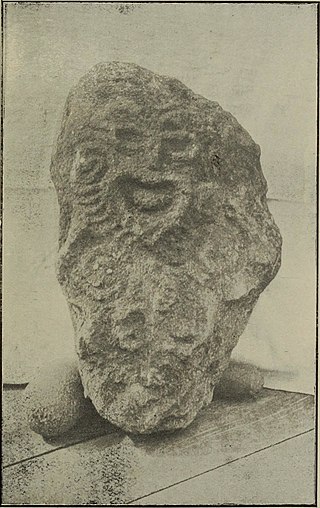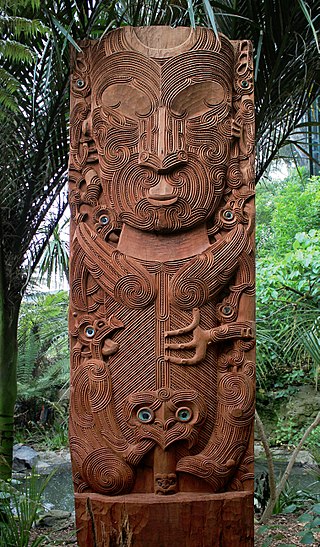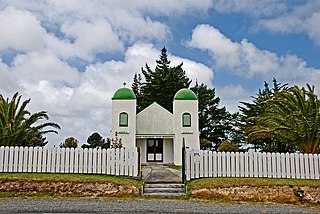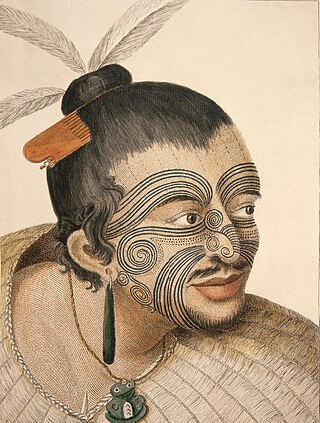Related Research Articles

In Māori mythology, Rongo or Rongo-mā-Tāne is a major god (atua) of cultivated plants, especially kumara, a vital crop. Other crops cultivated by Māori in traditional times included taro, yams (uwhi), cordyline (tī), and gourds (hue). Because of their tropical origin, most of these crops were difficult to grow except in the far north of the North Island, hence the importance of Rongo in New Zealand.

In Māori mythology the primal couple Rangi and Papa appear in a creation myth explaining the origin of the world and the Māori people. In some South Island dialects, Rangi is called Raki or Rakinui.

In Māori mythology, Tāne is the god of forests and of birds, and the son of Ranginui and Papatūānuku, the sky father and the earth mother, who used to lie in a tight embrace where their many children lived in the darkness between them.
Tangaroa is the great atua of the sea, lakes, rivers, and creatures that live within them, especially fish, in Māori mythology. As Tangaroa-whakamau-tai he exercises control over the tides. He is sometimes depicted as a whale.
According to the mythology of the Cook Islands, Amai-te-rangi was a cannibal and demon who attempted to entrap Ngaru. Ngaru, however, ascended and successfully defeated Amai-te-rangi with the help of his grandfather, Mokoroa.

In Cook Islands mythology, Avatea was a lunar deity and the father of gods and men in Mangaian myth of origin. His eyes were thought to be the Sun and the Moon; he was also known as the god of light.
Motoro is a god in Polynesian mythology, the tribal god of the Ngariki of Mangaia. He is the son of Tangiia and the brother of Ruanuku, Kereteki and Utakea. While travelling to Mangaia he argued with his two eldest brothers, was thrown into the sea, and devoured by sharks. His spirit then floated to Mangaia on a piece of hibiscus. He was known as i'o ora because his followers could not be used as human sacrifices.
Ngaru is a mythological hero from Avaiki (Hawaiki) in the mythology of Mangaia in the Cook Islands. Ngaru's mother was Vaiare and his grandfather the great lizard Moko. His wife was the beautiful Tongatea. To prove his prowess, he battles Tikokura and the shark Tumuitearetoka, who he outwits with the aid of Moko. he later descends to the underworld and returns to the land of the living where he subsequently defeats the sky fairies and Amai-te-rangi, a sky demon.

Paikea is a notable ancestor who originated in Hawaiki according to Māori tradition. He is particularly known to tribes with origins in the Gisborne District such as Ngāti Porou, and Ngāi Tahu. Paikea is the name assumed by Kahutia-te-rangi because he was assisted by a whale to survive an attempt on his life by his half-brother Ruatapu.
Lizard King may refer to:

Mangaia is the most southerly of the Cook Islands and the second largest, after Rarotonga. It is a roughly circular island, with an area of 51.8 square kilometres (20.0 sq mi), 203 kilometres (126 mi) from Rarotonga. Originally heavily populated, Mangaia's population has dropped by 75% in the last 50 years.

Sir Peter Henry Buck, also known as Te Rangi Hīroa or Te Rangihīroa, was a New Zealand doctor and a prominent anthropologist who served many roles through his life.

Te Aupōuri is the second northernmost Māori iwi, located north of Kaitaia, Northland, New Zealand, a region known as the Te Hiku o te Ika. The iwi is one of the six Muriwhenua iwi of the far north of the North Island.

Tā moko is the permanent marking or "tattoo" as traditionally practised by Māori, the indigenous people of New Zealand. It is one of the five main Polynesian tattoo styles.

In Māori mythology, Punga is a supernatural being, the ancestor of sharks, lizards, rays, and all deformed, ugly things. All ugly and strange animals are Punga's children. Hence the saying Te aitanga a Punga used to describe an ugly person.
Rarohenga is the subterranean realm where spirits of the deceased dwell after death, according to Māori oral tradition. The underworld is ruled by Hine-nui-te-pō, the goddess of death and night. Additional occupants include guardians, gods, goddesses, holy chiefs and nobles (rangatira), and the tūrehu, who are described as celestial, fairy-like people. Rarohenga is predominantly depicted as a place of peace and light. As articulated by Māori ethnographer Elsdon Best: It is a place where darkness is unknown. "This is the reason why, of all spirits of the dead since the time of Hine-ahuone…, not a single one has ever returned hither to dwell in this world".

Easter Island was traditionally ruled by a monarchy, with a king as its leader.

Taonga pūoro are the traditional musical instruments of the Māori people of New Zealand.
In Cook Islands mythology, Tumu-te-ana-oa was the female personification of Echo. She was the fourth child of Vari, the primordial mother goddess. Both her name and the land she occupied had to do with the production of echoes. Her name means "the cause (tumu) of the call or voice (oa) heard from caves (ana)". The term oa is used by people when calling out to evoke an echo. Her land was Te Parae-tea, which Gill translates, "The-hollow-gray-rocks". Mamae gives no more detail, but Gill recounts that Tumu-te-ana-oa frequented the caves of Mangaia, where she was seen by Rangi, one of the first inhabitants. The cave in which she was first seen was Aitu-mamaoa.
Rangi Kipa is a New Zealand sculptor, carver, illustrator and tā moko artist.
References
- ↑ Michael P. J. Reilly (2015). "NGARU: A CULTURE HERO OF MANGAIA" (PDF). Journal of the Polynesian Society. 124 (2): 147-187. Archived (PDF) from the original on 2018-02-12. Retrieved 2 September 2020.
- ↑
- W.W. Gill, Myths and Songs from the South Pacific (H.S. King: London, 1876)